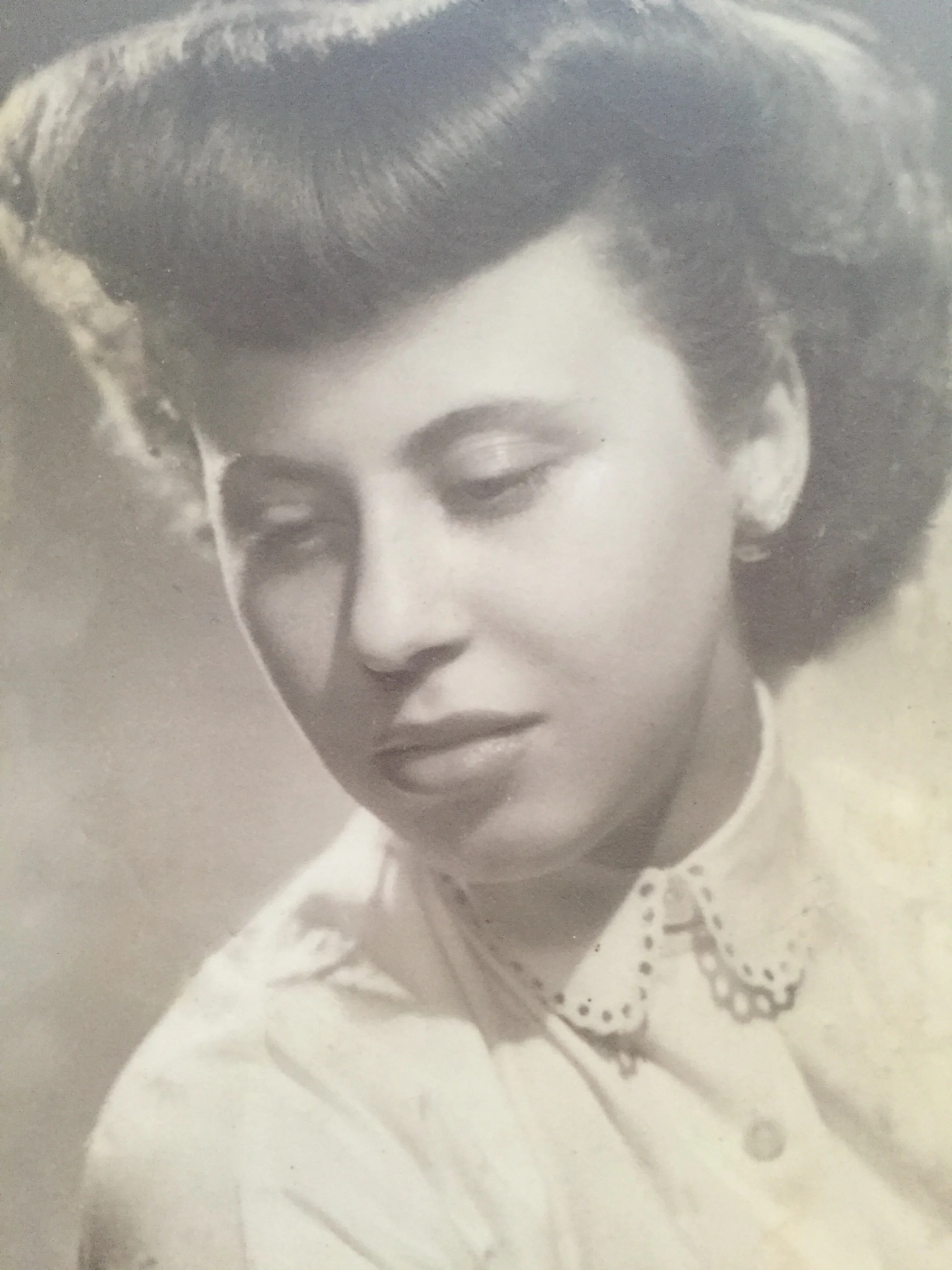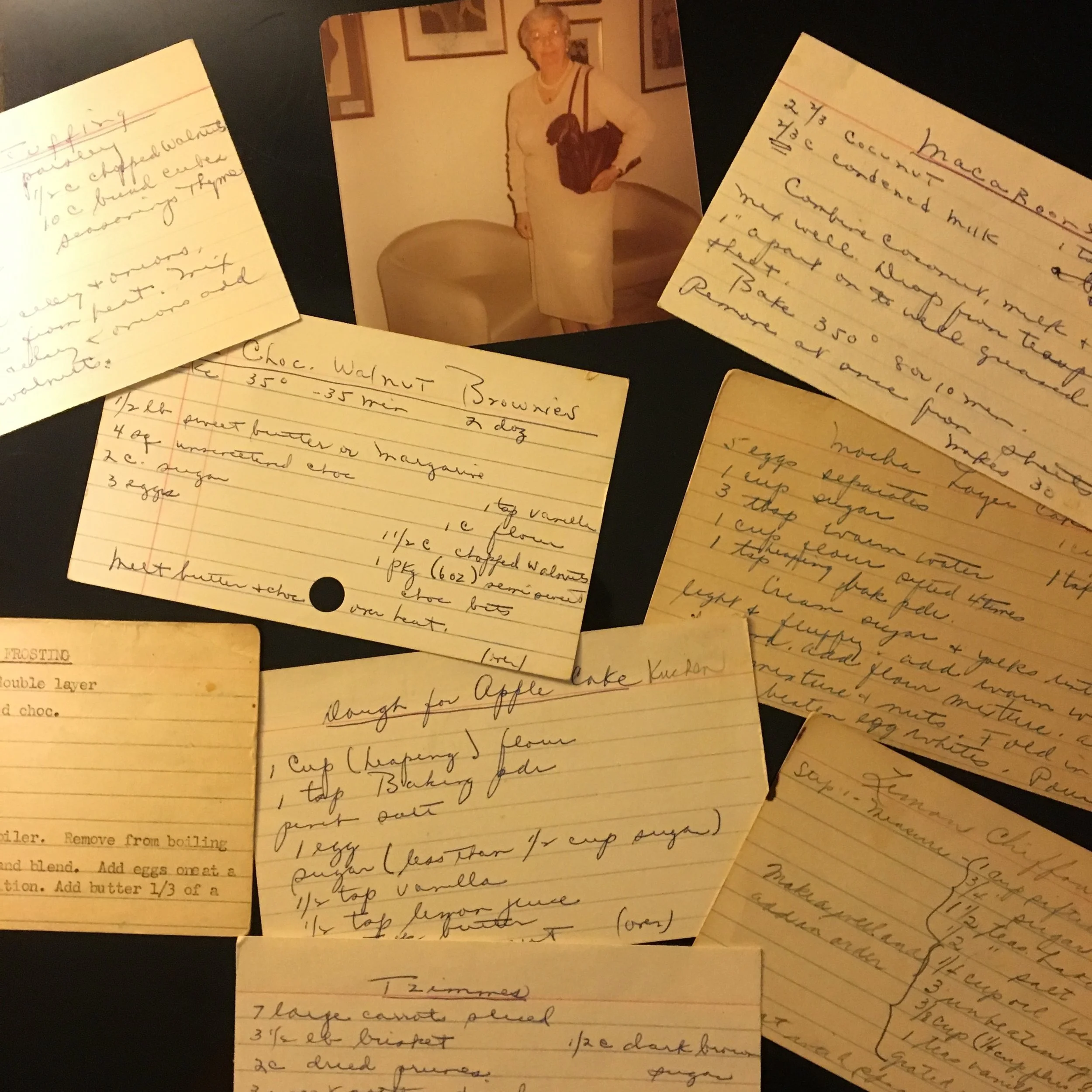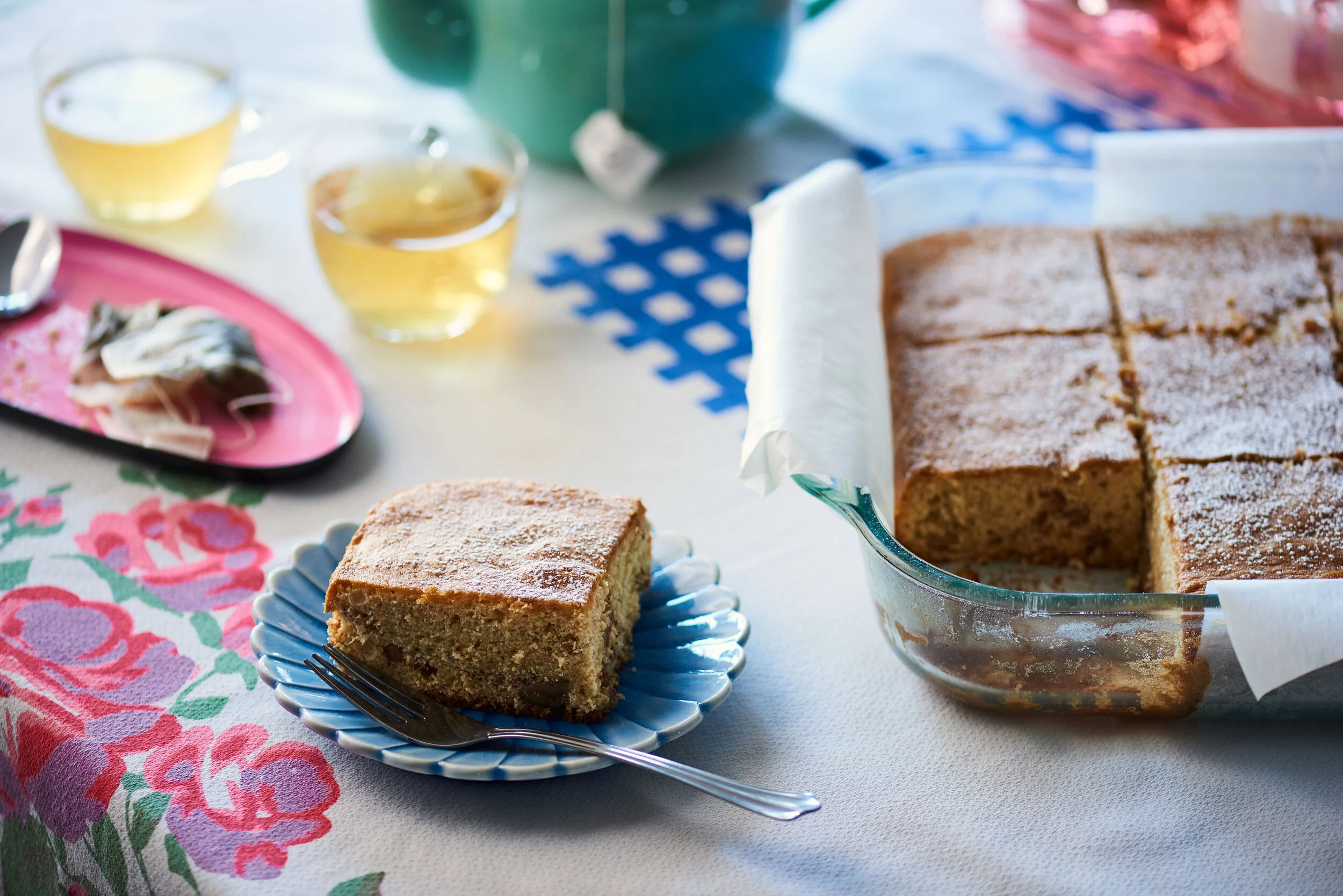A Mother’s Chicken Paprikash Recipe Lives On
Shared by Alex Sternberg
Recipe Roots: Auschwitz-Birkenau > Ravensbrück > Dombovar, Hungary > Pápa, Hungary > New York
“Looking back, no dinner was complete without Auschwitz appearing on the menu. I digested my meals together with the stories of my parents’ painful memories,” Alex Sternberg writes in Recipes from Auschwitz. There were meals of goulash, vegetable soup, chicken paprikash, spaetzle, stuffed cabbage, sour cherry soup, and other classics from Hungary.
Olga in Dombóvár, Hungary in the 1940s.
It wasn’t just the stories of Auschwitz and other camps where his parents Olga and Marton were sent during the war that appeared on the table. It was the recipes themselves that came from the camps. In Auschwitz-Birkenau and Ravensbrück, a women’s concentration camp where Olga was sent, women would “cook” together. Cooking here was not a physical act, rather it was one of recollection and storytelling.
“They would take turns describing how they had prepared their favorite dishes before the war. They would describe their kitchens and the fine linen and china they would set upon the table. Then they would describe their families who would eat these scrumptious meals—family members they had been separated from and perhaps with whom they would never be reunited,” Alex writes. The cooking sessions sustained Olga and the women she lived with.
A well educated woman, Olga was accustomed to memorizing poetry in Latin, Hungarian, and Greek. She committed to memory the recipes of the women she cooked with as well. Before the war, she hadn’t cooked much. It was in the camps that she learned to “cook.”
After the war, Olga returned to her hometown of Dombóvár in the south of Hungary and stayed in contact with two sisters she grew close to in Ravensbruck. One of the sisters invited Olga to visit her in Pápa, in northwestern Hungary, to introduce her to Marton, a devoutly religious Jew and a widower. Olga wasn’t raised in a religious home, but as she and Marton dated and ultimately married, she became religiously observant. Shabbat dinners were a staple in the home they created. “I fondly remember those Shabbos meals while I was growing up,” Alex writes. “My mother served her delicious dinners, cooked with the recipes she had learned in Auschwitz.”
The recipes followed the family when they moved to New York in 1961 escaping Communism and anti-Semitism. They were prepared in Boro Park where the family lived for a time and later in Canarsie where Marton bought a house. It wasn’t until nearly 30 years later that the recipes were passed down to Alex when he got divorced. He gained custody of his son and his mother felt he needed to learn to cook.
This year, another 30 years later, on the anniversary of Olga’s passing, or yahrzeit, the recipes were passed to the next generation. Unable to gather a minyan (a Jewish quorum) to recite the mourner’s Kaddish, Alex gathered his family and his brothers’ family on Zoom. Everyone had cooked one of Olga’s recipes from Alex’s book — and many of Alex’s nieces and nephews have continued to make the dishes since, keeping Olga’s memory alive.
Olga's Chicken Paprikash
Makes: 6 servings
Total Time: 1 hour 30 minutes
Ingredients
3 tablespoons cooking oil
8 chicken legs, bone-in and skin-on
1 yellow onion, finely chopped
½ green or red bell pepper, de-stemmed, de-seeded and finely chopped
2 teaspoons sweet paprika
2 teaspoons salt
½ teaspoon ground black pepper
5 to 6 parsley stalks with leaves
Preparation
1. Place the oil into a large pot over medium high heat.
2. Once the oil is hot, gently place the chicken pieces into the pot and sear on both sides until golden brown, about 5 minutes on each side. Transfer the seared chicken onto a plate.
3. Reduce the heat to medium and add the onions into the same pot and saute, stirring occasionally, until soft, about 8 to 10 minutes.Add the pepper into the pot and cook for another 3 to 5 minutes or until the peppers soften.
4. Add the chicken back into the pot with the onions and peppers.
5. Add the paprika, salt, pepper and parsley and mix to coat the chicken.
6. Add 3 cups of water to the pot or enough to cover the chicken ¾ the way up.
7. Bring the pot to a simmer over medium heat and cover with a lid. Continue cooking over a gentle simmer for 30 minutes. Remove the lid and reduce the heat to medium low, cooking the chicken on a gentle simmer for another 20 to 30 minutes or until the liquid reduces in half and the chicken is cooked and tender.
8. Serve the chicken paprikash hot with spaetzle.
Spaetzle
Spaetzle is a pasty, doughy, dumpling-like noodle that goes well with chicken paprikash or any saucy meat dish. Although you can cut the dough into pieces with a knife or spoon, a spaetzle maker (to cut the noodles) is easier to use and is available from many kitchen stores.
Makes: 4 servings
Total Time: 20 minutes
Ingredients
4 eggs
½ cup water
2 ½ cups all-purpose flour
2 teaspoons salt
2 tablespoons cooking oil
Preparation
1. In a medium mixing bowl, whisk the eggs. Add the water and stir in the flour and salt. Mix well until the mixture becomes a pasty, sticky dough.
2. Fill a medium pot halfway with water and bring to a boil over a high heat. Add the oil.
3. Set the spaetzle maker atop the pot of boiling water. Gently force the dough through the perforations in the spaetzle maker into the boiling water.
4. When all the dough has been cut into the boiling water, continue cooking it for another 2 to 3 minutes. The spaetzle is done when it floats to the top.
5. Strain the spaetzle and rinse in cold water.
6. Serve with chicken paprikash.
Recipes adapted from Recipes from Auschwitz by Alex Sternberg.
Olga’s Chicken Paprikash
Makes: 6 servings
Total Time: 1 hour 30 minutes
Ingredients
3 tablespoons cooking oil
8 chicken legs, bone-in and skin-on
1 yellow onion, finely chopped
½ green or red bell pepper, de-stemmed, de-seeded and finely chopped
2 teaspoons sweet paprika
2 teaspoons salt
½ teaspoon ground black pepper
5 to 6 parsley stalks with leaves
Preparation
1. Place the oil into a large pot over medium high heat.
2. Once the oil is hot, gently place the chicken pieces into the pot and sear on both sides until golden brown, about 5 minutes on each side. Transfer the seared chicken onto a plate.
3. Reduce the heat to medium and add the onions into the same pot and saute, stirring occasionally, until soft, about 8 to 10 minutes.Add the pepper into the pot and cook for another 3 to 5 minutes or until the peppers soften.
4. Add the chicken back into the pot with the onions and peppers.
5. Add the paprika, salt, pepper and parsley and mix to coat the chicken.
6. Add 3 cups of water to the pot or enough to cover the chicken ¾ the way up.
7. Bring the pot to a simmer over medium heat and cover with a lid. Continue cooking over a gentle simmer for 30 minutes. Remove the lid and reduce the heat to medium low, cooking the chicken on a gentle simmer for another 20 to 30 minutes or until the liquid reduces in half and the chicken is cooked and tender.
8. Serve the chicken paprikash hot with spaetzle.
Spaetzle
Spaetzle is a pasty, doughy, dumpling-like noodle that goes well with chicken paprikash or any saucy meat dish. Although you can cut the dough into pieces with a knife or spoon, a spaetzle maker (to cut the noodles) is easier to use and is available from many kitchen stores.
Makes: 4 servings
Total Time: 20 minutes
Ingredients
4 eggs
½ cup water
2 ½ cups all-purpose flour
2 teaspoons salt
2 tablespoons cooking oil
Preparation
1. In a medium mixing bowl, whisk the eggs. Add the water and stir in the flour and salt. Mix well until the mixture becomes a pasty, sticky dough.
2. Fill a medium pot halfway with water and bring to a boil over a high heat. Add the oil.
3. Set the spaetzle maker atop the pot of boiling water. Gently force the dough through the perforations in the spaetzle maker into the boiling water.
4. When all the dough has been cut into the boiling water, continue cooking it for another 2 to 3 minutes. The spaetzle is done when it floats to the top.
5. Strain the spaetzle and rinse in cold water.
6. Serve with chicken paprikash.












